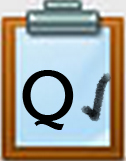Q1 The Search is ON! Vocabulary
Key Vocabulary
Attribution: Attribution is giving credit to the author or creator of a work.
Citation: A citation is a quotation from or reference to a book, image, paper, photograph, or author of a creative or scholarly work.
Commercially: Sharing photos commercially is buying, selling, or making a profit on those photos.
Copyright: Copyright is the legal right to be the only one to reproduce, publish, and sell a book, musical recording, etc., for a certain length of time.
Copyright License: A license clearly defines the copyright of your creative work so people know how to use it.
GIF: Graphics Interchange Format is best for short clips. It does not have sound and reduces the size of images and brief animations.
JPG (JPEG): Joint Photographic Experts Group) is great for sharing images with others. These have less data, so they are usually smaller file sizes.
Plagiarism: Plagiarism is taking someone else's work or ideas and passing them off as one's own.
PNG: Portable Network Graphics are best for complex images (used by web designers), especially those that have graphics with transparent backgrounds.
Properties: Properties are characteristics used to describe an object.
SVG: Scalable Vector Graphics are images primarily designed for the internet that are stored based on mathematical formulas of points and lines on a grid.
Play the interactive Quizlet Game: Direct link
Competencies & Standards
MITECS Michigan Integrated Technology Competencies for Students, and
2. Digital Citizen
b. Engage in positive, safe, legal and ethical behavior when using technology, including social interactions online or when using networked devices
c. Demonstrate an understanding of and respect for the rights and obligations of using and sharing intellectual property
3. Knowledge Constructor
a. Plan and employ effective research strategies to locate information and other resources for their intellectual or creative pursuits
b. Evaluate the accuracy, perspective, credibility and relevance of information, media, data or other resources
c. Curate information from digital resources using a variety of tools and methods
6. Creative Communicator
a. Choose the appropriate platforms and tools for meeting the desired objectives of their creation or communication
Websites and Documents
Websites
- ClipArt images for Classroom Use
- Creative Commons
- Creative Commons Image Search
- KidSearchImages
- Lifeofpix
- Picography
- Pics4learning
- When to Use the JPG, GIF, PNG, and SVG Formats
Videos from Outside Sources
- New Google Images Search Options YouTube (3:29) (Students will watch the first 1:49 mins. of this video)
21t4s Websites
21t4s Documents & Quizzes




